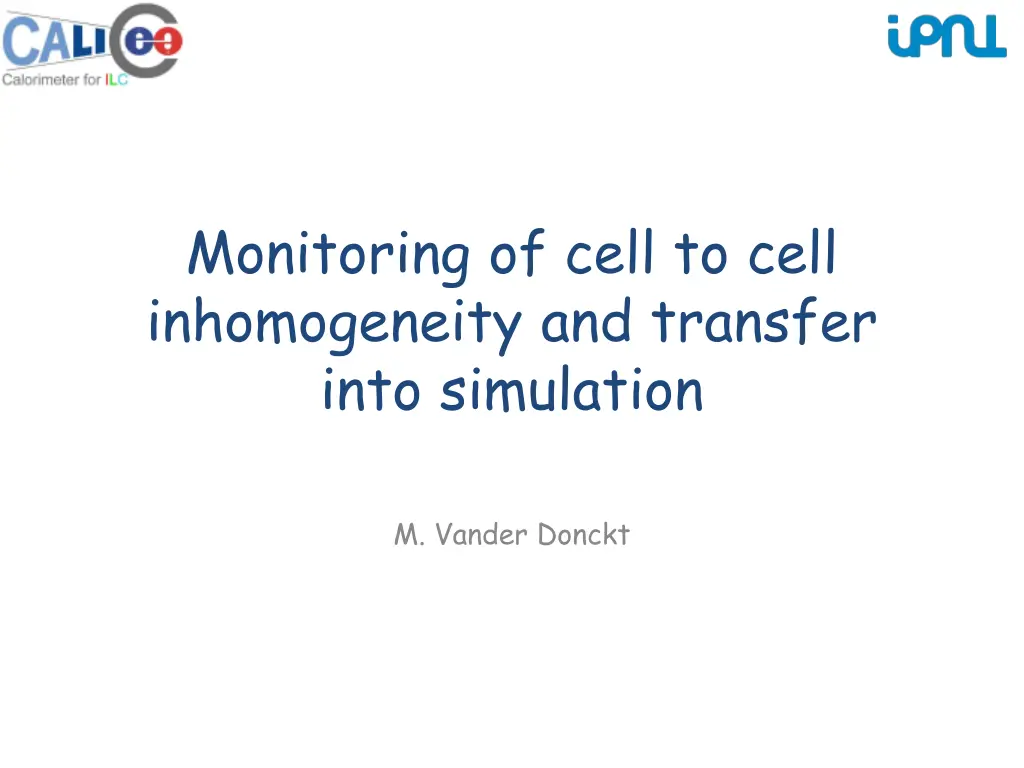
Cell-to-Cell Inhomogeneity Monitoring and Transfer Simulation
Explore the detailed process of monitoring cell-to-cell inhomogeneity and its transfer into simulation in electronics research. Topics include ASIC testing, detector calibration, threshold uniformity, stability monitoring ideas, and efficiency homogeneity studies.
Download Presentation

Please find below an Image/Link to download the presentation.
The content on the website is provided AS IS for your information and personal use only. It may not be sold, licensed, or shared on other websites without obtaining consent from the author. If you encounter any issues during the download, it is possible that the publisher has removed the file from their server.
You are allowed to download the files provided on this website for personal or commercial use, subject to the condition that they are used lawfully. All files are the property of their respective owners.
The content on the website is provided AS IS for your information and personal use only. It may not be sold, licensed, or shared on other websites without obtaining consent from the author.
E N D
Presentation Transcript
Monitoring of cell to cell inhomogeneity and transfer into simulation M. Vander Donckt
Electronics: ASICs test facility The ASICs have been tested by R. della Negra using Labview-based application (cf. N. Seguin) The resulting gain correction is used as input for on detector calibration 03/02/2011 February GRPC SDHCAL review 2
Pedestals on detector Pads 35 3 03/02/2011 February GRPC SDHCAL review
On detector calibration From R. della Negra 1st threshold 1.015 DAC/fC Set asic DAC0 threshold =average pedestal+100 Check of threshold dispersion Charge injection not an absolute calibration due to unprecise injected charge knowledge 03/02/2011 February GRPC SDHCAL review 4
Threshold uniformity 10 pads/asic for ~100fC (?) Dispersion ~7.5% (compared to 5% at ASIC test level) Mean threshold-Mean Ped=125DAC 03/02/2011 February GRPC SDHCAL review 5
Ideas for threshold monitoring Stability of charge injection threshold vs time for DAC0/1 and 2 (not absolute calibration) Stability of MIP threshold vs HV (for DAC0 and DAC1) Stability of ratios of number of pads above threshold 0 1 & 2 for given energy pions 03/02/2011 February GRPC SDHCAL review 6
Uniformity measurement To be done with cosmics as soon as we have 4 chambers Associate 3 collinear coincident clusters and predict in 4th chamber. Will allow multiplicity and efficiency uniformity measurement 1 cosmic/cm2/min -> Threshold scan over 120 DAC with ~10 tracks per pad in 20h Measurement of MIP peak withDAC0 & DAC1 03/02/2011 February GRPC SDHCAL review 7
Efficiency homogeneity studies HV: 7.5 kV Position scan area Homogeneous >95% Results obtained using time selection only 1m2GRPC map February GRPC SDHCAL review 8 03/02/2011
Multiplicity homogeneity studies HV: 7.5 kV Multiplicity highly depends on threshold level Homogeneous <1.3 for threshold ~0.25 MIP Results obtained using time selection only Preliminary 1m2GRPC map R. Kieffer 03/02/2011 9 February GRPC SDHCAL review
Inhomogeneity in simulation Dispersion of threshold/multiplicity can be added at the digitization level Idea to introduce pad multiplicity vs track position in simulation : Divide cells in 3x3 cells (Mokka) and compute probability of neighboring pads to be hit at digitization level (Marlin) as a function of the track entry sub-pad. M2 student starting end Feb to work on measurement/implementation. K. Belkhadi 03/02/2011 February GRPC SDHCAL review 10
Conclusion This is work in progress... Charge injection calibration can be improved by better impedance matching Will start using LPC Volcano data to start cosmic uniformity measurements 03/02/2011 February GRPC SDHCAL review 11
